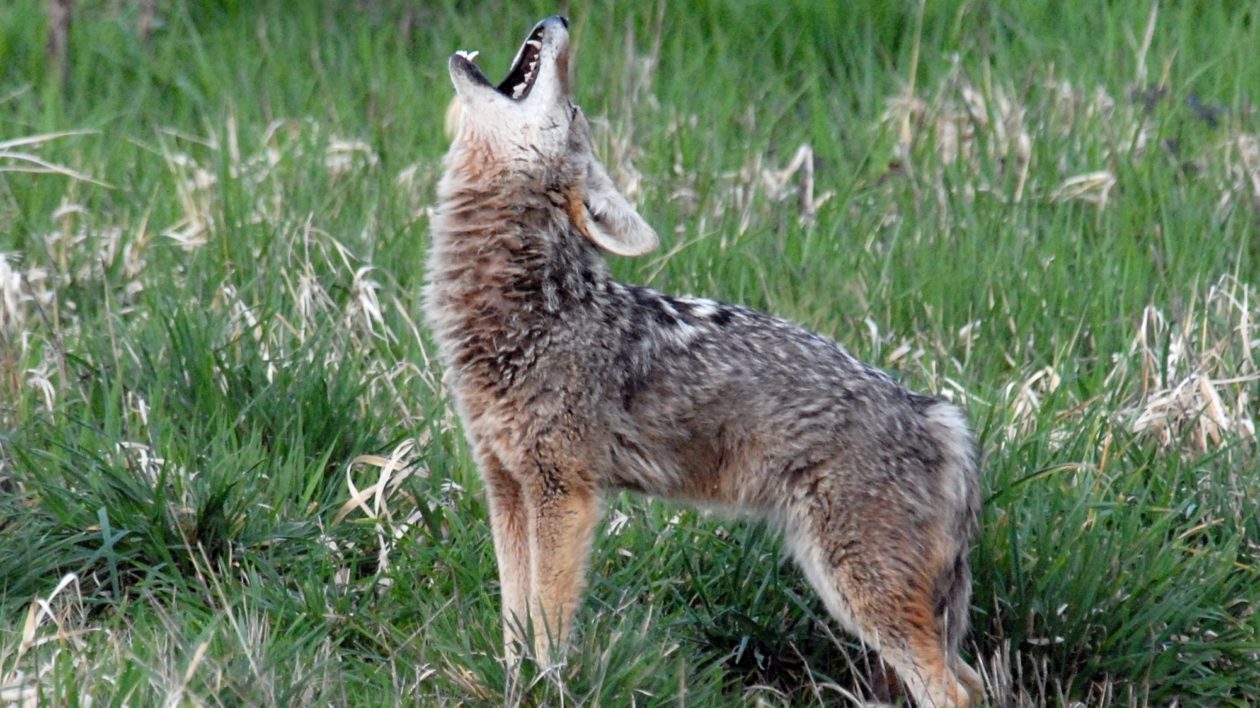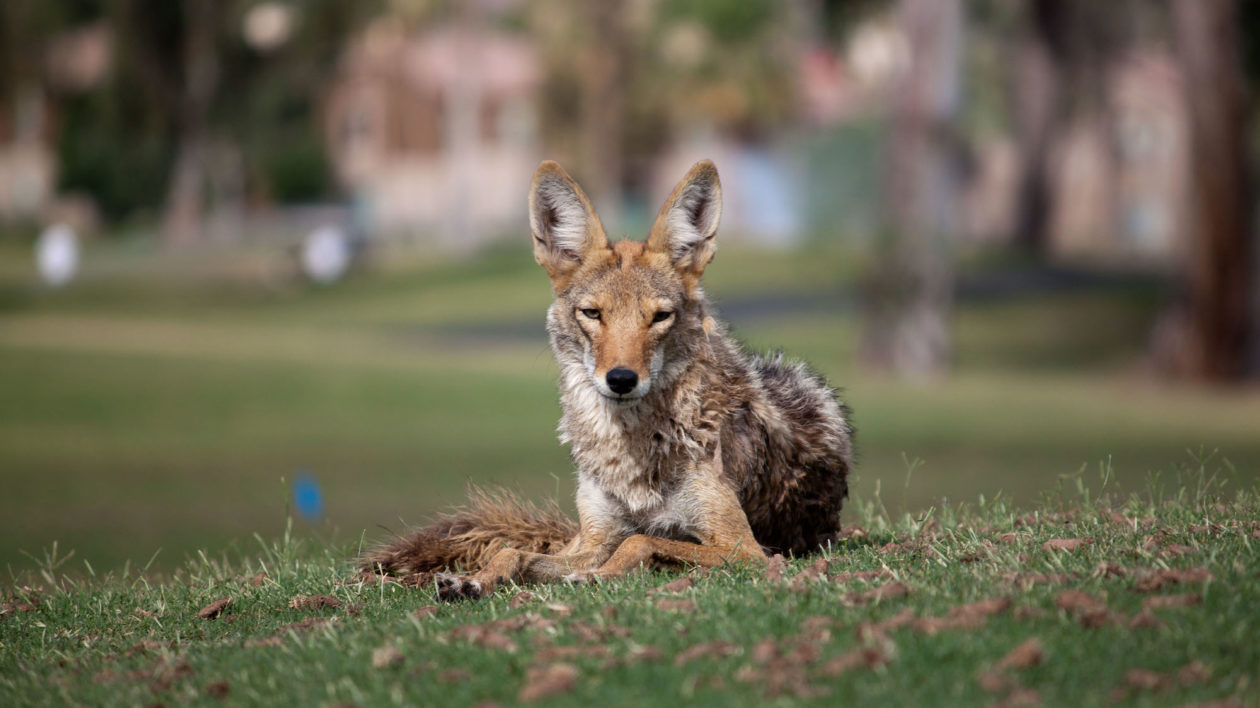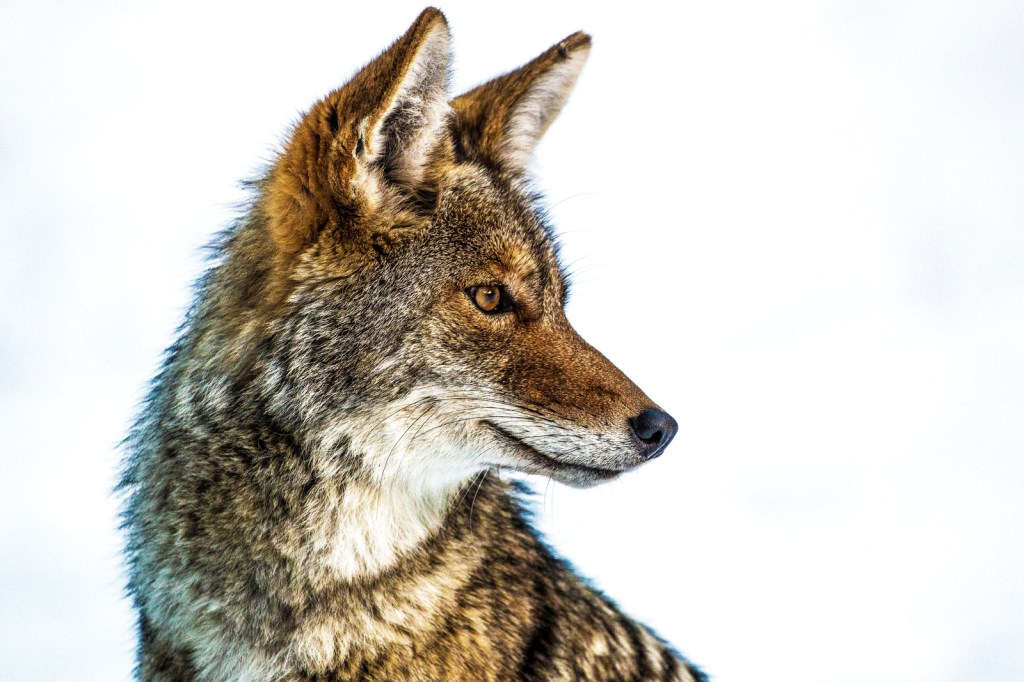I stepped outside last night to take some glass bottles to the recycling bin. The evening was clear, cold and seemingly silent. I hurried with my task, no wanting to linger in the chill. And then a howl rippled through the air. Coyote. The sound echoed through the neighborhood, carrying clearly from a nearby hillside.
I stopped and enjoyed the vocalizations. The long howls were interspersed with sharp yips, sounding like multiple animals. It lasted for several minutes.
I never tire of that sound, no matter how many times I hear it. And this time of year, I enjoy the coyote concert frequently.
Coyotes are one of the most vocal mammals. And they’re also now found widely, so if you live in North America, there’s a good chance that you have some roaming near you.
You can hear them at any time of year, but you may notice increased activity in February and March. And, if you’re like me, you’ll find the howling particularly resonant on a cold winter’s night. Here’s what’s going on.

The Pair Bond
Quite simply, it’s breeding season. While the exact timing varies, depending on geography, coyote breeding season generally occurs between late January and March. Coyotes are generally monogamous, forming strong pair bonds for several years. Some researchers state that the coyotes will remain together until one of the pair dies.
Coyotes are also territorial. The pair howls and yips to let other coyotes know that they have an established territory and not to intrude.
Coyote researcher Brian Mitchell describes the sounds you’re likely to hear at this time of year:
“Group yip-howls are produced by a mated and territorial pair of “alpha” coyotes, with the male howling while the female intersperses her yips, barks, and short howls. “Beta” coyotes (the children of the alpha pair from previous years) and current year pups may join in if they are nearby, or respond with howls of their own.”
Mitchell also notes that other nearby pairs may then respond, announcing their own territories. At such times, it can sound like a cascade of howls across the landscape.
According to Mitchell, this is not the only time of year that coyotes establish their territorial boundaries. The pups are born later in spring, and will form a loose family group. A pack of coyotes howling is an iconic sound of the American West, and it likely serves dual functions. Mitchell writes:
“The group yip howl is thought to have the dual purpose of promoting bonding within the family group while also serving as a territorial display. In other words, the coyotes are saying “we’re a happy family, and we own this turf so you better keep out.” In a sense, the group howls create an auditory fence around a territory, supplementing the physical scent marks left by the group.”

Song Dog
Howling may be the most recognizable coyote vocalization, but these canids actually have a wide repertoire of sounds. (One of the animal’s more endearing nicknames is “song dog”). Researchers generally identify 11 vocalizations that serve a variety of functions, from alarm to warning to socialization.
There is much we don’t understand about the coyote’s calls. Their “language” is likely far more complex than we can comprehend. Researchers like Mitchell note that coyotes have accents that vary geographically and even among family groups, much like humans. And coyotes can recognize another coyote by its distinctive call.
Even though coyotes are one of the most common and adaptable predators in the world, there is much we don’t understand. And there’s also a lot of contradictory information – and complete nonsense – written about coyotes.
There are two reasons for this. Coyotes are relentlessly persecuted throughout their range. A lot of people kill or attempt to kill coyotes, and oftentimes they present their own opinions as fact.
For instance, people often grossly overestimate the number of coyotes in an area. When a couple of coyotes begin calling, their sounds can vary rapidly in pitch and sequence, which can sound like a lot more coyotes than actually are there. Coyote howls often echo against hillsides, compounding the confusion.
This actually may provide a benefit to coyotes. As they establish their territory, sounding like a big pack may deter other coyotes from entering the territory.
I have often heard local hunters describe areas “absolutely overrun with coyotes,” based solely on the howling they’ve heard. Most likely, they were fooled by just a few animals.

A Flexible Lifestyle
I suspect there is another reason for a lot of the contradictory information about coyotes and their behavior. It’s because coyotes behave differently depending on habitat, interactions with humans and other factors.
Coyotes are one of the most adaptable predators. They are found in the Idaho wilderness near my home, but also can live in the midst of large cities like Chicago and Los Angeles. They live in farm country, in suburbs and in urban parks.
The reason that they can thrive in so many different habitats is that they are very flexible and adaptable. They will change their diet and their habits to fit the environment.
So a coyote’s territory and pack bonds are likely different on the public lands of the Rocky Mountains than they are in a suburban neighborhood.
One of the differences some researchers have recognized is that urban coyotes likely vocalize less. I live in an area surrounded by a large wildlife management area and a river greenbelt. I hear coyotes regularly. If you live in a city, you may not hear coyotes as much – but that doesn’t mean they’re not there. They have just found it easier to survive by being quiet.
If you do happen to find yourself in some wide-open spaces this month, step outside in the night and have a listen. You may enjoy one of the great sound shows in nature, the chorus of yips and howls. The coyote survives and thrives despite us, and its howling serves as a reminder to the wildness still in the world.




Super article Mathew, my wife Geri and I had one cross our path last year in our small
suburban area near Pittsburgh. Reminded us of our 8 year summer job in YNP , late’90’s
to 2007, Worked for Hamilton Stores & DNC at Lake junction, YNP. Have many
coyote pics including the kits in caves, and a coyote trying to chase a Grizzly away
from her kit near the ocean. Thanks again for the article.
Richard
Should we have an inability to accept the coyote, that would indicate that Nature doesn’t accept us. I hope the sound dogs’ howling is another one of Nature’s ways of telling us that.
Should I fear a pack of coyotes?
Very interesting and informative. I too love hearing the coyotes around our home. We have a Yorkshire terrier that throws his head back and joins in, answering the call of the wild.
Really nice article, thank you for sharing.
Very interesting, I live in a small town in Illinois and I see coyotes in the morning sometimes in our neighborhood. They seem attracted to the barking of the dogs in some yards. There very beautiful animals, I just worry that there looking for someones pet as their next meal.
I live on Camano Island WA and heard them just last night. Awesome!!
I enjoyed this info. I think they are beautiful and enjoyed learning more about them. Thank you.
Thank you for the article. I enjoyed learning more about the coyotes. While visiting Los Angeles, I saw a pair walking in the street in Silverlake. They have a distinct gait. I was at first cautious and made sure to keep an eye on them. They seemed not to be bothered with me nearby, and now I understand how adaptable they are to urban neighborhoods. I assume they must have been a male and female.
I have heard, constantly; that they will “entice” a domestic dog to follow them back to the pack; and then tear the dog to pieces. Is this true?
very informative article.. i live in n.e. Washington and surrounded by hills.. i do know their howling ‘bounces’ off the hills in the s.w. of me when they are howling to the north of me in ‘them thar hills’….. 🙂
What a wonderful article — I live in the county and we see and hear coyotes regularly — they have, unfortunately, snatched a couple of chickens, cats and a turkey — but I don’t begrudge them their dinner. We live between the suburbs and a national park. They are here! Without coyotes, we’d be overrun with field rats and mice, which is something a lot of people don’t understand. Whenever I hear the complaining about coyotes and that they should be hunted down, my response is they’d be a lot more unhappy with the rodent population explosion that would follow the demise of the coyote. I have to admire an animal that has been able to adapt so well to a rapidly changing environment. (Kind of sounds like another creature with which we are all personally well- acquainted. )
I was so pleased and relieved to read your blog about coyotes. I live in a suburb about 20 miles south of Seattle and have a greenbelt behind our house. I had heard, as many have, that coyotes sometimes kill especially smaller pets. Before reading your article I used to really dread hearing the coyotes howling and yipping at night because I thought it meant they were killing some poor defenseless animal and possibly someones dearly loved pet. It sometimes tormented me and I’d cover my ears because I hated hearing them. I know, of course, that it is natural for them to kill animals to eat and survive. I just dont want to “hear” them doing it. I am so very relieved that is not what they are doing and now I can actually enjoy their “singing” and know that they are just communicating with each other and establishing their territory. Thank you so much for writing this.